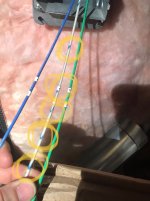DC26
Member
- Location
- Washington, DC
I have just had an inspector tell me my neutral conductors are not code compliant because they do not have a "continuous white outer finish." He hasn't failed my inspections yet but has asked for a code article to prove that the neutral conductors my crews have spent weeks pulling are code compliant.
Backstory:
I've attached a picture. My traces do not identify the source of manufacture. Is this wiring actually non-compliant? The intent of section 200.6 is to ensure consistent colors for neutrals so that future electricians can identify them by sight. My install does not violate that intent. Does it violate the letter of the Code? Maybe.
Has anyone else ever had an inspector come to them with this objection before? Is anyone aware of additional Code sections that provide for "traces" like these? Obviously I don't want to go back and replace thousands and thousands of feet of installed wire.
Thanks for helping a new poster.
Backstory:
I have been pulling #12 and #10 branch circuitry in an industrial/commercial setting, all in EMT. The building is part of a large campus and the owner is their own AHJ.
I pulled my 120/208v neutrals as white THHN conductors that came from the factory with either a black, red, or blue "trace" to help my electricians ensure that neutrals are not crossed. Though not a spec on this job, this "trace" has been a spec on other jobs and I've pulled neutrals like this for years. The actual wire is "Encore Wire" Superslick. I've installed wire like this in multiple jurisdictions and never had any pushback from inspectors.
NEC (2017 version) 200.6(A)(1) reads:
An insulated grounded conductor, #6 and smaller shall be identified by one of the following means:
(1) A continuous white outer finish.
(2) A continuous gray outer finish.
(3) Three continuous white or gray stripes along the conductor's entire length on other than green insulation.
(4) Wires that have their outer covering finished to show a white or gray color but have colored tracer threads in the braid identifying the source of manufacture shall be considered as meeting the provisions of this section.
(5) -- only applies to MI cable --
(6) -- only applies to photovoltaic installs --
(7) -- only applies to fixture wires --
(8) -- only applies to aerial cable --
I've attached a picture. My traces do not identify the source of manufacture. Is this wiring actually non-compliant? The intent of section 200.6 is to ensure consistent colors for neutrals so that future electricians can identify them by sight. My install does not violate that intent. Does it violate the letter of the Code? Maybe.
Has anyone else ever had an inspector come to them with this objection before? Is anyone aware of additional Code sections that provide for "traces" like these? Obviously I don't want to go back and replace thousands and thousands of feet of installed wire.
Thanks for helping a new poster.


